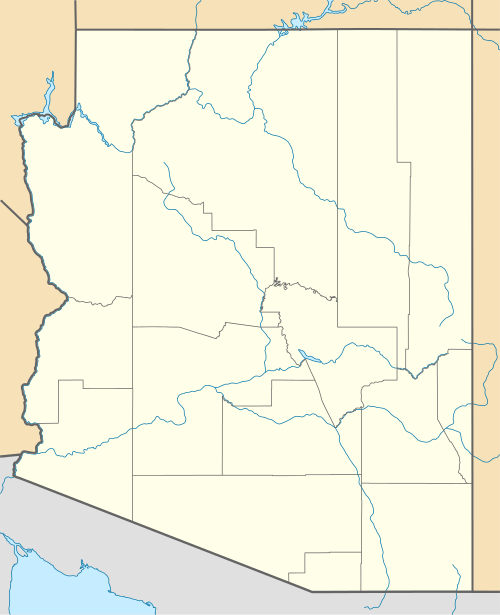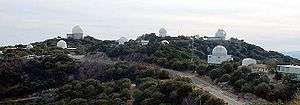Kitt Peak National Observatory
|
Overview of some of the telescopes at the Kitt Peak National Observatory | |||||||||||||||||||||||||||||||||||||||||||||||
 Kitt Peak National Observatory Location in Arizona | |||||||||||||||||||||||||||||||||||||||||||||||
| Organization | NOAO | ||||||||||||||||||||||||||||||||||||||||||||||
|---|---|---|---|---|---|---|---|---|---|---|---|---|---|---|---|---|---|---|---|---|---|---|---|---|---|---|---|---|---|---|---|---|---|---|---|---|---|---|---|---|---|---|---|---|---|---|---|
| Code | 695 | ||||||||||||||||||||||||||||||||||||||||||||||
| Location | Tohono O'odham Nation, Arizona, United States | ||||||||||||||||||||||||||||||||||||||||||||||
| Coordinates | 31°57.5′N 111°35.8′W / 31.9583°N 111.5967°WCoordinates: 31°57.5′N 111°35.8′W / 31.9583°N 111.5967°W | ||||||||||||||||||||||||||||||||||||||||||||||
| Altitude | 2,096 metres (6,877 ft) | ||||||||||||||||||||||||||||||||||||||||||||||
| Weather | 72% clear nights | ||||||||||||||||||||||||||||||||||||||||||||||
| Website |
www | ||||||||||||||||||||||||||||||||||||||||||||||
| Telescopes | |||||||||||||||||||||||||||||||||||||||||||||||
| |||||||||||||||||||||||||||||||||||||||||||||||
|
| |||||||||||||||||||||||||||||||||||||||||||||||
The Kitt Peak National Observatory (KPNO) is a United States astronomical observatory site located on 2,096 m (6,880 ft) Kitt Peak of the Quinlan Mountains in the Arizona-Sonoran Desert on the Tohono O'odham Nation, 88 kilometers (55 mi) west-southwest of Tucson, Arizona. With 24 optical and two radio telescopes, it is the largest, most diverse gathering of astronomical instruments in the world.[1] The observatory is administered by the National Optical Astronomy Observatory (NOAO).
General information
Kitt Peak was selected by its first director, Aden B. Meinel, in 1958 as the site for a national observatory under contract with the National Science Foundation (NSF) and was administered by the Association of Universities for Research in Astronomy. The land was leased from the Tohono O'odham under a perpetual agreement. The second director (1960 to 1971) was Nicholas U. Mayall. In 1982 NOAO was formed to consolidate the management of three optical observatories — Kitt Peak; the National Solar Observatory facilities at Kitt Peak and Sacramento Peak, New Mexico; and the Cerro Tololo Inter-American Observatory in Chile. The observatory sites are under lease from the Tohono O'odham Nation at the amount of a quarter dollar per acre yearly, which was overwhelmingly approved by the Council in the 1950s. In 2005, the Tohono O'odham Nation brought suit against the National Science Foundation to stop further construction of gamma ray detectors in the Gardens of the Sacred Tohono O'odham Spirit I'itoi, which are just below the summit.[2]
The principal instruments at KPNO are the Mayall 4 metre telescope; the WIYN 3.5 metre telescope; and further 2.1 m, 1.3 m, 0.9 m, and 0.4 m reflecting telescopes. The McMath-Pierce Solar Telescope on the facilities is the largest solar telescope in the world and the largest unobstructed reflector (it doesn't have a secondary mirror in the path of incoming light). The ARO 12m Radio Telescope is also in the location.
Kitt Peak is famous for hosting the first telescope (an old 91 cm reflector) used to search for near-Earth asteroids, and calculating the probability of an impact with planet Earth.[3]
Kitt Peak hosts an array of programs for the public to take part in:
- Daily, there are three tours that are guided by staff, speaking about the history of the observatory as well as touring a major research telescope.
- Each night, the Kitt Peak Visitor Center hosts its Nightly Observing Program, which allows visitors to arrive in the late afternoon, watch the sunset, and use binoculars and telescopes to view the cosmos.[4]
- Additionally, there is the Advanced Observing Program (AOP) for advanced amateur astronomers. This program allows for a one-on-one, full-night tour using any of the visitor's center’s telescopes. Guests may choose to do DSLR imaging, CCD imaging, or simply take in the sights with their eye to the telescope.[5]
Kitt Peak's Southeastern Association for Research and Astronomy (SARA) Telescope was featured in the WIPB-PBS documentary, "Seeing Stars in Indiana". The project followed SARA astronomers from Ball State University to the observatory and featured time-lapse images from various points around Kitt Peak.[6][7]
Photos
 Solar telescope, looking down
Solar telescope, looking down View of Kitt Peak looking towards the Mayall 4-meter telescope
View of Kitt Peak looking towards the Mayall 4-meter telescope- Two of Kitt Peak's telescopes (right: Mayall 4-m telescope; left: Bok 2.3-m telescope)
 380° panorama of Kitt Peak from the Warner and Swasey Observatory
380° panorama of Kitt Peak from the Warner and Swasey Observatory 400° panorama from Kitt Peak's Mayall 4-meter Observatory
400° panorama from Kitt Peak's Mayall 4-meter Observatory
Climate
Due to its high elevation, the observatory experiences a much cooler and wetter climate throughout the year than most of the Sonoran desert.
| Climate data for Kitt Peak, Arizona (Elevation 6,790ft) | |||||||||||||
|---|---|---|---|---|---|---|---|---|---|---|---|---|---|
| Month | Jan | Feb | Mar | Apr | May | Jun | Jul | Aug | Sep | Oct | Nov | Dec | Year |
| Record high °F (°C) | 71 (22) |
75 (24) |
78 (26) |
88 (31) |
90 (32) |
98 (37) |
98 (37) |
94 (34) |
91 (33) |
89 (32) |
87 (31) |
72 (22) |
98 (37) |
| Average high °F (°C) | 49.6 (9.8) |
50.8 (10.4) |
54.3 (12.4) |
61.7 (16.5) |
70.4 (21.3) |
79.5 (26.4) |
80.4 (26.9) |
78.0 (25.6) |
74.9 (23.8) |
66.9 (19.4) |
56.8 (13.8) |
50.0 (10) |
64.4 (18) |
| Average low °F (°C) | 33.0 (0.6) |
33.6 (0.9) |
35.8 (2.1) |
41.3 (5.2) |
49.2 (9.6) |
58.5 (14.7) |
60.8 (16) |
59.8 (15.4) |
57.0 (13.9) |
48.6 (9.2) |
39.5 (4.2) |
33.7 (0.9) |
45.9 (7.7) |
| Record low °F (°C) | −3 (−19) |
−2 (−19) |
9 (−13) |
15 (−9) |
24 (−4) |
33 (1) |
40 (4) |
42 (6) |
35 (2) |
20 (−7) |
12 (−11) |
6 (−14) |
−3 (−19) |
| Average precipitation inches (mm) | 1.77 (45) |
1.60 (40.6) |
1.80 (45.7) |
0.55 (14) |
0.44 (11.2) |
0.45 (11.4) |
4.38 (111.3) |
4.53 (115.1) |
2.36 (59.9) |
1.50 (38.1) |
1.14 (29) |
2.65 (67.3) |
23.16 (588.3) |
| Average snowfall inches (cm) | 3.0 (7.6) |
4.3 (10.9) |
4.1 (10.4) |
1.2 (3) |
0.1 (0.3) |
0 (0) |
0 (0) |
0 (0) |
0 (0) |
0.3 (0.8) |
1.2 (3) |
3.8 (9.7) |
18.1 (46) |
| Source: The Western Regional Climate Center[8] | |||||||||||||
See also
References
- ↑ National Optical Astronomy Observatory (NOAO). "Kitt Peak National Observatory". Retrieved 18 February 2012.
- ↑ "Astronomy development on another sacred mountain: Kitt Peak". Retrieved 16 February 2009.
- ↑ "The Spacewatch Project". Retrieved 16 February 2009.
- ↑ "Kitt Peak Visitor Center & Museum: Nightly Observing Program - Program Description". Noao.edu. Retrieved 2012-08-17.
- ↑ "Kitt Peak Visitor Center & Museum: Advanced Observing Program - Introduction". Noao.edu. Retrieved 2012-08-17.
- ↑ Kevin Grazioli. "Seeing Stars in Indiana". Retrieved 17 February 2012.
- ↑ Seeing Stars In Indiana (Adobe Flash Player). 2011. Retrieved 17 February 2012.
- ↑ "Seasonal Temperature and Precipitation Information". Western Regional Climate Center. Retrieved 6 December 2014.
Further reading
External links
| Wikimedia Commons has media related to Kitt Peak National Observatory. |
- Kitt Peak National Observatory - official site
- Kitt Peak National Observatory Visitor Center - visiting and tour information
- Kitt Peak Webcam
- Kitt Peak NightSkyLive overhead webcam, nighttime only
- Kitt Peak Clear Sky Chart Forecasts of observing conditions
- NOAA general forecast for KPNO
- NOAA detailed forecast for KPNO
- Observing At Kitt Peak - General Overview for Observers and Staff
